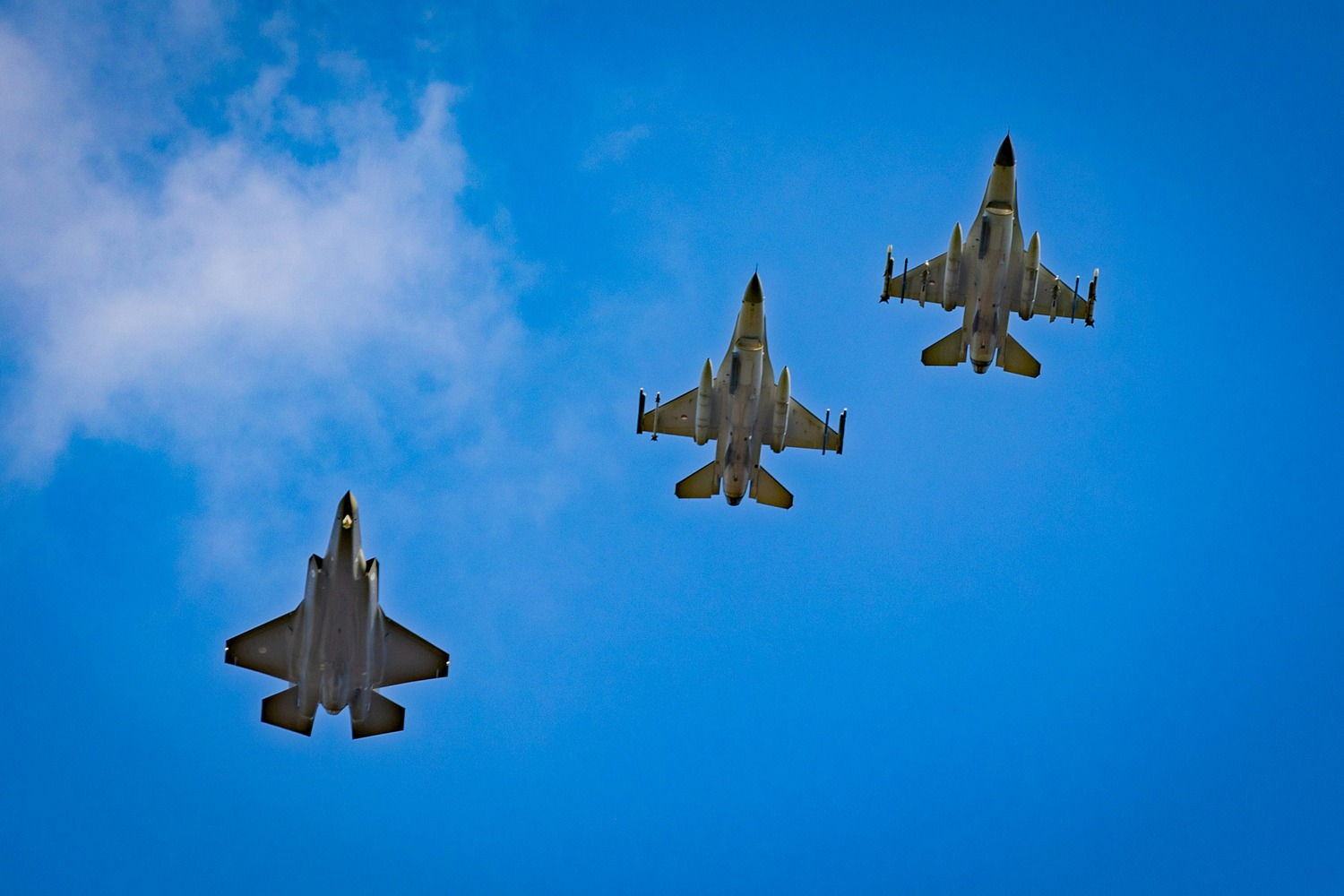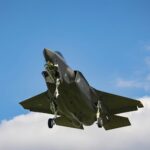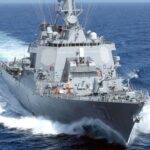The F-35 promised reach without rival, yet its heart – Pratt & Whitney’s F135 – burns fuel like an older design. Thrust-specific fuel consumption (TSFC) shows why. The F100-PW-229 that powers late-model F-15s and F-16s clocks 0.726 lb/hr/lb. The F135 sits at 0.889 lb/hr/lb, a 22 percent penalty that drags range and keeps tankers busy.
That gap traces to the Joint Strike Fighter’s one-aircraft-fits-all deal. The Marine Corps wanted short take-off and vertical landing. To hover, the engine must gulp more air, so engineers widened the fan and beefed up the core. A wide fan adds drag to the cruise and demands extra kerosene to stay lit. The Air Force and Navy inherited that thirsty core for missions that never call for vertical lift.
High burn carries clear costs. The Air Force rates the F-35A’s unrefueled combat radius at 590 nautical miles, barely ahead of a legacy F-16 with conformal tanks. A slimmer powerplant could stretch that by roughly one-fifth – enough to skip a tanker track or keep a carrier farther offshore. Better fuel flow would also cool the exhaust, easing infrared signature and maintenance wear, but those gains stayed on the drawing board.
Core statistics underline the compromise:
- F100-PW-229 (F-15/F-16): TSFC 0.726
- F110-GE-129 (Block 52 F-16): TSFC 0.73
- EJ200 (Eurofighter): TSFC 0.74
- F135 (F-35): TSFC 0.889
The numbers alone do not fly sorties, yet they force planners to add more KC-135 or KC-46 launches for each deploying wing. The tanker bill will haunt budgets long after unit prices settle.
Performance is only one headache. Reliability data from the Director, Operational Test & Evaluation tells a harder story. Fully mission-capable (FMC) rate peaked at 62 percent in December 2014 and slid to 21 percent by October 2016. Availability averaged just 52 percent over the same period, well below the modest 60 percent goal. With readiness that low the jet struggles to replace the aging A-10 or F/A-18 in day-to-day tasking.
Engine health drives much of that downtime. In 2013 every F-35 stopped flying when a turbine blade cracked during test, prompting a fleet-wide inspection. A year later a “hot rub” destroyed AF-27 on rollout and grounded the fleet again. Those fixes added weight, increased part counts, and fed an emerging depot backlog.
Money follows trouble. The fiscal 2016 price tag for one F-35A reached $119.6 million, while the F-35B and F-35C crossed $160 million and $180 million. Lockheed Martin projects $85 million per A-model at full-rate output, but no independent audit backs that figure. Meanwhile sustainment models already top $1.1 trillion for the life of the program, most of it fuel, parts, and engines. Recent data shows that engine unit costs continue to grow even as production scales up.
Allies take notice. Israel accepts F-35s only because Foreign Military Financing covers the bill. Jerusalem quietly orders more F-15EX airframes for long-range strikes, citing better payload, proven sensors, and simpler logistics. Australia, Norway, and Italy report spares shortfalls that hold jets in shelters for weeks. Danish lawmakers voice second thoughts after reading early operating cost tallies, while Canada delays its final buy.
Critics at the Project on Government Oversight warn the aircraft “cannot meet basic readiness or cost targets” and call the engine compromise a prime cause. A fighter that spends four days in the hangar for every day airborne risks losing wars of attrition, no matter how stealthy on paper.
The F-35 still brings modern sensors and low radar cross-section, yet commanders cannot skip physics. A heavy, wide-fan motor drinks fuel. More fuel means bigger inlets, hotter ducts, and tougher cooling problems for onboard electronics. Each fix adds weight, and every pound subtracts acceleration, climb, and, finally, survivability.
WHAT’S NEW — March 2025
Eight years passed, and the compromise still echoes. On 3 March 2025, Pratt & Whitney celebrated one million F135 flight hours – an impressive mark that also reveals the scale of sustainment work ahead. The engine keeps the fleet flying, but depot backlogs remain. At the start of 2025, 37 powerplants sat in queues awaiting module repair, double the target figure set in 2020.
Congress chose upgrade over replacement. The fiscal 2024 appropriations act fully funded the F135 Engine Core Upgrade (ECU) to raise thermal margin and durability for Block 4 avionics. The Pentagon then awarded a not-to-exceed $1.3 billion contract extension in October 2024 to carry the design through critical review. First retrofit kits will not reach squadrons until 2029, leaving four more years of heat-driven wear and costly inspections.
General Electric’s XA100 adaptive engine finished a third test phase in 2023, but the Air Force froze funding and kept the F135 as the sole option. Industry lobbying continues, yet service leaders insist an all-new core would cost time the program no longer owns. Secretary Kendall called the ECU “the fastest path to margin” and shut the door – for now.
Sustainment math grew harsher. A GAO brief to Congress in January 2025 raised projected life-cycle support costs to $1.58 trillion, a 44 percent jump since 2018. Engine overhaul, spare modules, and tanker fuel are the fastest-rising lines. The report warns that without deeper fixes, the Air Force and Navy will breach their affordability caps inside seven years.
Field data underline the risk:
- Fleet flight hours: ≈1,050,000
- Average engine removal interval: ≈900 hours (goal 2,100)
- Full mission capable rate, Feb 2025: 34 percent
- ECU retrofit earliest squadron cut-in: 2029
- GAO sustainment projection: $1.58 trillion
Supply lags hurt Pacific basing most. During January’s bilateral drills in Guam, Marine F-35Bs aborted six of 18 planned sorties as inlet temps exceeded limits when Block 4 mission computers ran at full load. Squadron maintainers swapped three engines in five days, but each swap consumed scarce lift fan gearboxes.
Yet not all news is grim. New high-pressure turbine blades with ceramic-matrix coatings survived 250 hours of accelerated tests last summer, beating earlier parts by 40 percent. Pratt says the design will enter production lots 23 and 24, trimming shop visits by one-third.
Partners still buy in. Canada signed for 88 F-35As last year, and Pratt opened a Montreal logistics hub that stocks F135 spares for the northern climate. European operators praise the jet’s sensor fusion during Baltic patrols but request faster parts flow under the Global Spares Pool. Pratt’s union shop in East Hartford adds weekend shifts to meet the pace, even as wage talks stretch into April.
For now the Lightning II flies on an engine engineered for hover first, range second. The ECU may claw back some efficiency, yet physics grants no free gifts. Until a lighter core arrives – or tankers change the math – the Joint Strike Fighter will keep paying at the pump.
REFERENCE SOURCES
- https://airandspaceforces.com/f-35sgroundedafterenginebladecrackdiscovered/
- https://www.secretprojects.co.uk/threads/comparison-of-modern-fighter-turbofans.37652/
- https://en.wikipedia.org/wiki/Pratt_%26_Whitney_F135
- https://www.dote.osd.mil/Portals/97/pub/reports/FY2016/dod/2016f35jsf.pdf
- https://docs.pogo.org/publication/defense-monitor/2016/defense_monitor_july_sept_2016.pdf
- https://www.prattwhitney.com/ar/newsroom/news/2024/03/23/rtxs-pratt-whitney-receives-full-funding-for-f135-engine-core-upgrade
- https://www.prattwhitney.com/en/newsroom/news/2025/03/03/rtxs-pratt-whitney-f135-engine-surpasses-1-million-flight-hours
- https://breakingdefense.com/2024/10/pentagon-awards-pratt-1-3-billion-to-continue-work-on-f-35-engine-upgrade/
- https://files.gao.gov/reports/GAO-25-108104.pdf
- https://breakingdefense.com/2023/11/as-third-test-phase-for-xa100-adaptive-engine-wraps-ge-mutes-f-35-pitch/
- https://breakingdefense.com/2023/03/air-force-will-not-develop-new-f-35-engine-keeping-pratt-as-sole-contractor/



